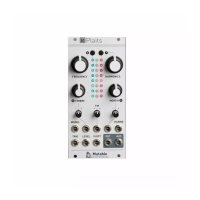Marbles’ recipe for random music
1. Start with a clock – generated internally or divided/mul-
tiplied from an external clock signal.
2. If required, add some jitter to it, from slight humaniza-
tion to complete chaos.
3. Split this randomized clock into two streams of random
triggers to generate two contrasting rhythmic patterns
complementing the main clock.
4. Generate three random voltages in sync with the rhyth-
mic patterns obtained at the previous step.
5. Transform the random voltages to spread them further
apart, or concentrate them around a specific voltage.
6. Add a pinch of lag-processing to obtain smooth random
modulations... or quantization to get random tunes.
Steps 1 to 3 are handled by the left half of the module, the
random rhythms being generated on the outputs labelledt.
In your Eurorack system such duties might have been per-
formed by modules like Grids and Branches.
Steps 4 to 6 are handled by the right half of the module, the
random voltages being generated on the outputs labelledX.
A large number of modules would be necessary to patch
this functionality: a triple noise source and sample&hold,
waveshapers, quantizers, and lag processors.
And now let’s take it further: what if everything the module
did could be controlled by a slowly evolving or lockable loop,
like with Music Thing’s Turing Machine? That’s what the
DEJA VU section is for.
Time to dive into the details!

